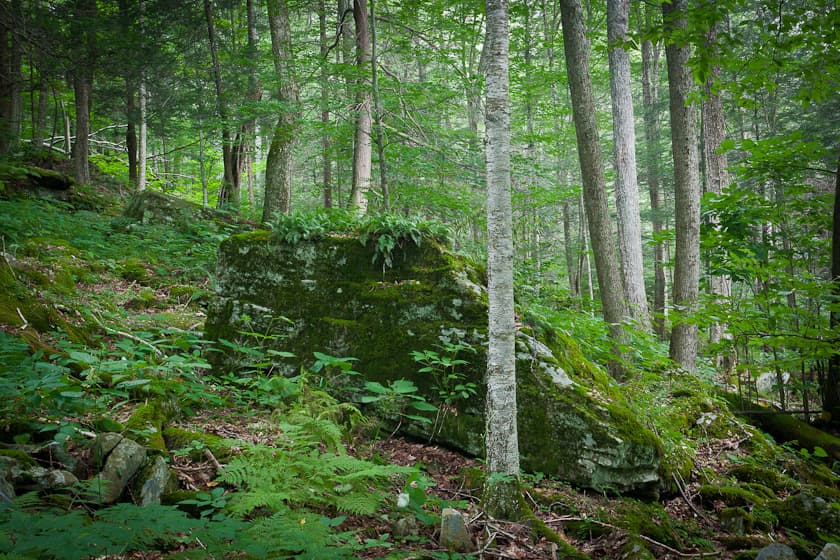These are our state’s coolest deciduous forests. They resemble forests that are more extensive in New England and around the Great Lakes. Similar forests also occur in small patches at high elevations in the mountains as far south as North Carolina and Tennessee. These forests are some of West Virginia’s most familiar and loved because they proliferate on public lands in our highlands, where outdoor recreation and nature abound.
Ecological Description
Northern Hardwood Forests are composed of a mixture of deciduous trees and understory shrubs and herbs that typically grow together at more northern latitudes. Common trees include American beech (Fagus grandifolia), red maple (Acer rubrum), black cherry (Prunus serotina), sugar maple (Acer saccharum), yellow birch (Betula alleghaniensis), and the less northern cucumber magnolia (Magnolia acuminata). Additional trees in some stands include Northern red oak (Quercus rubra), mountain magnolia (Magnolia fraseri), white ash (Fraxinus americana), sweet birch (Betula lenta), basswood (Tilia Americana), and yellow buckeye (Aesculus flava). Eastern hemlock (Tsuga canadensis) and red spruce (Picea rubens) may be scattered in the tree canopy; abundance of these conifers in the subcanopy and understory usually indicates succession towards their dominance (see WVWV fact sheets for Upland Hemlock – Hardwood Forests and Upland Red Spruce Forests). Characteristic subcanopy trees and shrubs include striped maple (Acer pensylvanicum), mountain holly (Ilex montana), and hobblebush (Viburnum lantanoides). Common herbs include intermediate woodfern (Dryopteris intermedia), New York fern (Thelypteris noveboracensis), Canada mayflower (Maianthemum canadense), mountain wood sorrel (Oxalis montana), hay-scented fern (Dennstaedtia punctilobula), painted trillium (Trillium undulatum), Jack-in-the-pulpit (Arisaema triphyllum), Indian cucumber-root (Medeola virginiana), halberd-leaf yellow violet (Viola hastata), great chickweed (Stellaria pubera), princess-pine (Lycopodium obscurum), mountain woodfern (Dryopteris campyloptera), yellow fairybells (Prosartes lanuginosa), and shining clubmoss (Huperzia lucidula).
In West Virginia, Northern Hardwood Forests usually occur in moist, cool climates at high elevations in the mountains (mostly >900m or 3000 ft), but one related association occurs at lower elevations in deep gorges with low solar exposure. Northern Hardwood Forests usually have acidic soils, but often with higher pH and fertility compared to adjacent conifer dominated forests. Soil chemistry is related to the rock type of the parent material: soils derived from sandstone are usually highly acidic with low base status while those derived from limestone and some shales may be less acidic, with higher base status. Differences in soil chemistry are reflected in tree and herb composition which justifies designation of a Rich Northern Hardwoods Forest on higher fertility soils. In areas with extremely acidic, nutrient poor soils, conifers may have a competitive advantage, such that dominance by deciduous trees represents a successional phase towards climax dominance by conifers. Northern Hardwood Forests on less acidic soils may be climax communities.
Animals that need these habitats
Rare animals associated with Upland Red Spruce Forests, such as Cheat Mountain salamander (Plethodon nettingi) and West Virginia northern flying squirrel (Glaucomys sabrinus fuscus), also use adjacent Northern Hardwood Forests. Northern goshawks (Accipiter gentilis) fly skillfully through forest canopies and in summer they breed in these habitats. Bear Creek slitmouth (Stenotrema simile), a land snail nearly endemic to West Virginia, lives under litter and logs. Two species of rabbits that use these habitats, Appalachian cottontail (Sylvilagus obscurus) and snowshoe hare (Lepus americanus), are regulated as game animals.
Distribution
WV’s Northern Hardwood Forests occur mainly in the Allegheny Mountains, but small patches of similar vegetation can be found in the Cumberland Mountains and in the Ridge and Valley. A large proporation occurs on the Monongahela National Forest. The land area occupied by Northern Hardwood Forests is thought to have increased following the logging boom (~1880-1920), corresponding to a decrease in forests dominated by red spruce and hemlock. WVDNR currently maps 994,851 acres (6.5% of WV’s land area) of Northern Hardwood Forests in the state, but this also includes significant areas of Upland Hemlock – Hardwood Forests and successional/ruderal forests.
Places to see and visit
Northern Hardwood Forests are prevalent in the Allegheny Mountains in the western half of the Monongahela National Forest. You are sure to see some on hikes in the Otter Creek Wilderness or Cranberry Wilderness. Get out of the car on Black Mountain along the south end of the Highlands Scenic Highway to look for WV’s only known stands of the Southern Appalachian Northern Hardwoods Forest. The Ridge and Valley Northern Hardwoods Forest can be found in WV on Shenandoah Mountain on the George Washington National Forest but it is apparently more common on the VA side of the border which runs along the ridgetop. Trails in the New River Gorge National River along Glade Creek and to Kate’s Branch Falls are good places to see the Upside Down Northern Hardwoods Forest.

Conservation issues
Northern Hardwood Forests are the matrix communities of West Virginia’s highlands and are important for many wildlife species adapted to a cool, moist climate. Fruits of beech and black cherry are especially important food sources for wildlife. The area of Northern Hardwood Forests is probably decreasing due to increasing area of conifer (red spruce and hemlock) dominated forests and from development pressure and exploitation for timber. Slowing this trend, some areas of early successional habitat and forests currently dominated by red oak are expected to become Northern Hardwood Forests in the future. Expansion of hemlock dominated forests may soon reverse due to infestation by the non-native insect pest hemlock wooly adelgid. The beech component of these forests is rapidly declining due to beech bark disease and the resulting proliferation of beech sprouts presents challenges in managed forests. There are very few old growth Northern Hardwood Forests known in WV, but old growth characteristics such as canopy gaps and woody debris develop relatively quickly due to frequent natural disturbances from ice storms and wind events. Northern Hardwood Forests are generally well protected on public lands, including in Wilderness Areas. The southernmost areas in the Allegheny Mountains are mostly on corporate timberlands, presenting different conservation challenges and opportunities. Black cherry, a valuable timber species, makes its best growth in Northern Hardwood Forests and is generally favored by frequent human disturbance. Red maple is also favored by disturbance. Strong dominance by these two disturbance species are probably beyond the natural range of variation for Northern Hardwood Forests. Small patches of Northern Hardwood Forests in the Ridge and Valley and Cumberlands may be especially vulnerable to climate change and land management actions such as timber harvest and controlled burns. Northern Hardwood Forests are not fire adapted.
USNVC Association WV Scientific Name [Common Name] | Code | G Rank | S Rank |
| Aesculus flava – Betula alleghaniensis – Acer saccharum / Caulophyllum thalictroides – Actaea podocarpa Forest [Southern Appalachian Northern Hardwoods Forest] | CEGL004973 | G3 | S1 |
| Acer (rubrum, saccharum) – Prunus serotina – Betula alleghaniensis – Fagus grandifolia / Maianthemum canadense Forest [Typical Northern Hardwoods Forest] | CEGL006045 | G4 | S4 |
| Acer saccharum – Tilia americana / Acer pensylvanicum / Allium tricoccum – Laportea canadensis Forest [Rich Northern Hardwoods Forest] | CEGL006637 | G4 | S3 |
| Betula alleghaniensis – (Tsuga canadensis, Liriodendron tulipifera) / Rhododendron maximum Forest [Upside Down Northern Hardwoods Forest] | CEGL007861 | G3 | S2 |
| Betula allegheniensis – Quercus rubra / Acer pensylvanicum / Dryopteris intermedia Forest [Ridge and Valley Northern Hardwoods Forest] | CEGL008502 | G3 | S1 |
Key to Associations
- Northern Hardwood Forests of high elevations (> 900 m) in the Allegheny Mountains.
- Northern Hardwood Forests at high elevations in the Ridge and Valley or at lower elevations in south-central WV.
- Forests at high elevations in the Ridge and Valley, currently only known from Shenandoah Mountain in Pendleton County. Quercus rubra and Betula alleghaniensis codominate the tree canopy. Ridge and Valley Northern Hardwoods Forest
- Forests at lower elevations in southcentral WV in deep gorges with low solar exposure. Betula alleghaniensis usually dominates the tree canopy, often with Liriodendron tulipifera and Tsuga canadensis and with a shrub layer dominated by Rhododendron maximum. Upside Down Northern Hardwoods Forest
- Northern Hardwood Forests with Aesculus flava, currently known only from the Yew Mountains in Pocahontas County. Southern Appalachian Northern Hardwoods Forest
- Aesculus flava absent.
- Northern Hardwood Forests on soils derived from highly acidic sandstone or shale. Forests dominated by a mixture of trees including Betula alleghaniensis, Prunus serotina, Acer saccharum, Acer rubrum, and Fagus grandifolia. Tilia americana and nutrient demanding herbs lacking. Typical Northern Hardwoods Forest
- Northern Hardwood Forests on soils derived from less acidic shale or limestone, or from sandstone in concave and lower slope positions. Often dominated by Acer saccharum with Tilia americana and Fraxinus americana mixed with typical northern hardwoods, with high cover by nutrient demanding herbs such as Laportea canadensis and Allium tricoccum. Rich Northern Hardwoods Forest









